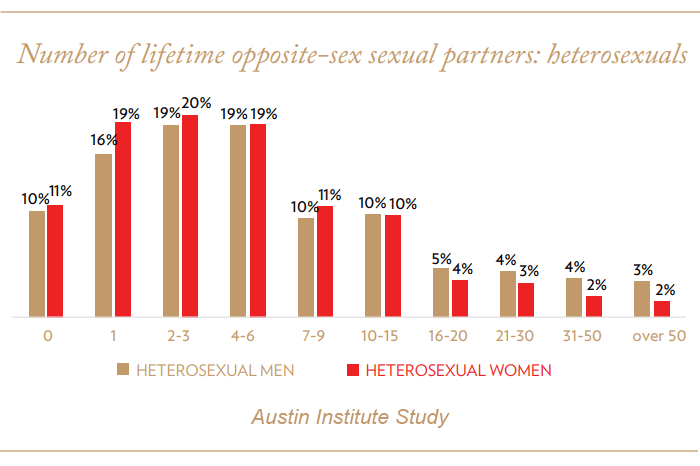How many people have Americans had sex with? Who has more partners, men or women? How does age or location factor into it? From the number of partners to the stigma attached to it, there’s much to uncover.
Let’s plunge into the intimate world of human relationships as we debunk myths, examine trends, and reveal societal attitudes along the way.
Decoding the Average Number of Sexual Partners in the U.S.
The question of the average number of sexual partners an American has had can yield surprising answers. The average number of sexual partners for American adults typically ranges between 4 and 14.8 partners. While the median number of sex partners for American women stands at 4.3, for men, it’s 6.3.

The distribution of promiscuity in the U.S. population is left-skewed, with the majority of individuals having a small number of partners, while a smaller segment shows high promiscuity, having a significantly higher number of partners.
Breaking Down the Numbers by Gender
Curious about how your “number” compares to the average number of sexual partners people have? The number varies by gender. On average, men in the U.S., U.K. and Europe have 8 sexual partners in their lifetimes, with women having 7.
Over the past five years, statistics show that 41% of women and 27% of men have been sexually active with a single partner. Although there is a general perception that men are more promiscuous than women, the statistics don’t back up that viewpoint.
Age Matters: Sexual Partners Through the Decades
Age plays a significant role in the number of sexual partners one has. The U.S. National Institute of Health performed an in-depth study and defined “sex” as vaginal sex between heterosexual people. It found that both males and females who were 15 to 24-years-old typically had 0–1 lifetime sex partners.
But in the 25 to 44-year-old age range, there is a large divergence of lifestime sex partners, with men usually having 10–39 lifetime sex partners, and women only having 2–4 partners.
When looking at just the past 12 months of sexual partners, both men and women age 15 to 24-years-old had an average of less than 1 (statistically) sexual partner, and both genders ages 25 to 44-years-old had an average of 1.5 partners.
The Spectrum of Sexual Experiences
Individuals’ sexual experiences can greatly differ. From committed relationships to casual encounters, the range is vast. Research indicates that 83% of men and 80% of women between the ages of 18 and 30 reported engaging in sexual activities, including oral sex, with a committed partner. The percentage for men in the 31-40 age group increased to 95%, while for women, it increased to 92%.
Conversely, 17% of men and 20% of women aged 18-30 reported engaging in sexual activity with someone other than their spouse or partner. This suggests that women report a slightly higher percentage of sexual encounters outside of committed relationships among younger adults, as women tend to be more open in sharing their experiences.
Regional Variations in Sexual Partner Count
There’s also geographical variation in the number of sexual partners. Residents of the State of Washington get the prize for having the highest average number of sexual partners, with an average of 55. On the opposite end of the spectrum, people in Pennsylvania, South Carolina, and Colorado have the lowest average number of sexual partners, which is 8.6 across their lifetime.
This regional variation in sexual partner count can be influenced by various factors, including cultural and social differences. For instance, the average number of sexual partners in Utah is likely influenced by the state’s religious demographics, with over 62% of residents being members of the Church of Jesus Christ of Latter-day Saints, which promotes abstinence until marriage.
Understanding Sexual Behavior Trends
Contrary to popular belief, young adults aren’t as promiscuous as frequently portrayed. Through the years, there has been a decrease in the median age at sexual initiation among different cohorts and shifts in the prevalence of selected sexual behaviors and contraceptive use measures in a national sample, which some might attribute to the impact of the sexual revolution.
The National Survey of Sexual Health and Behavior is the largest survey focused on sexual behaviors to have been performed in the U.S. It included over 20,000 people. Some interesting trends emerged from it.
One is that kissing while having sex is outdated, with those under 30 years of age much less likely to kiss because it would be too intimate. Another is that Americans described over 40 different combinations of sexual activity when they recounted their most recent sexual experience.
For adults aged 65 to 80 years old, 76% said that sex is an important part of their relationship, showing that older people are still sexually active. And the last big interesting trend is that people over 40 years of age have the lowest rates of condom use.
The Impact of Relationship Status
Relationship status significantly influences the number of sexual partners. For instance, women who have only engaged in sexual activity with their spouses are more likely to report very happy marriages, which suggests a lower number of sexual partners.
Higher divorce rates are linked to marrying and having multiple premarital sexual partners, indicating a greater number of sexual partners.
The typical range of sexual partners in casual relationships can vary significantly due to factors such as:
-
Age range
-
Country
-
Gender
-
Sexuality
These factors often result in a higher partner count. As individuals move through different stages of a relationship, they may witness a shift in the number of sexual partners. Divorced or separated individuals typically report a higher number of sexual partners when compared to never-married individuals.
Sexual History and Health Considerations
A person’s sexual history can have health implications. If either (or any) of the people involved have had unprotected sexual activity with multiple partners, their sexual history can:
-
Increase their susceptibility to sexually transmitted infections (STIs)
-
Affect their comfort level in discussing sexual health, particularly in instances of negative childhood experiences or trauma
-
Increase the risk of contracting human immunodeficiency virus (HIV) and various sexually transmitted diseases (STDs)
To reduce health risks when having sex with someone who has had multiple sexual partners, it is recommended to:
-
Engage in open communication
-
Practice safer sex
-
Use condoms
-
Consider mutual monogamy
-
Limit the number of sexual partners
-
Undergo regular STD testing
The Social Stigma of Body Count
Even with increased gender equality, social stigma linked to the number of sexual partners persists. The more sexual partners they have had, the more women are still looked down on as promiscuous and loose. With men, it’s still the opposite. The greater the number of sexual conquests, the more of a man he is. The less he has, the more something must be wrong with him.
The U.S. National Institute of Health did a study that showed that homosexual individuals have had more partners than heterosexual individuals. But what constitutes “sex” could have a skewed effect on these numbers.
In particular, the LGBTQIA+ community, along with 58.6% of its members, often encompasses non-penetrative activities in their tally of sexual partners. Similarly, 53.6% of Generation Z individuals are inclined to consider non-penetrative sexual encounters as contributing to their count.
The presence of social stigma related to the number of sexual partners continues to be significant, as individuals are judged based on their sexual history.
Honesty and Disclosure: Talking About Past Partners
The topic of discussing past partners is a touchy subject because both genders know that they will be judged according to their answers. This often leads women to underreport the number of partners they’ve had, and men to overreport.
How much to under or overreport depends on a number of considerations, such as perceived societal norms in their socioeconomic circles, personal insecurities, the desire to appear more experienced or appealing, and worries about the impact on current or future relationships.
Dishonesty about past sexual partners can undermine trust and have a negative impact on the well-being of a relationship. While some individuals advocate for open communication on the topic, others assert that fudging one’s true “number” is an acceptable white lie.
The “Ideal” Number Debate
The concept of an “ideal” number of sexual partners is subjective and varies widely. There is no universally agreed-upon ideal number of sexual partners, as it varies for each individual. Several factors influence what an okay number is, including:
-
Characteristics of the relationship
-
Inaccurate perceptions about a partner’s concurrent sexual partners
-
Timing of sexual partnerships
-
Social influences such as familiarity and similarity
Cultural backgrounds and personal experiences also influence these perceptions. For instance, the influence of cultural backgrounds on these perceptions is evident through the impact of laws, religion, and social norms.
The number of sexual partners an individual has is influenced by various factors such as age, gender, relationship status, and location.
Honesty and disclosure in sexual relationships are critical, both for a healthy relationship and for the physical health of one’s body. There is no universally ideal number of sexual partners for every person, as it varies based on individual preferences, cultural backgrounds, and experiences.





